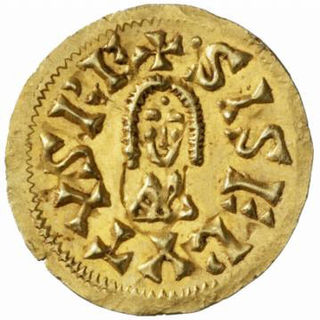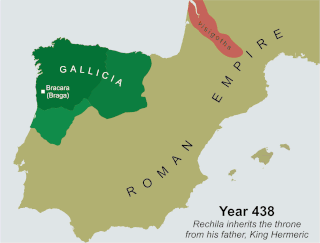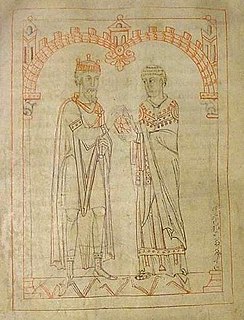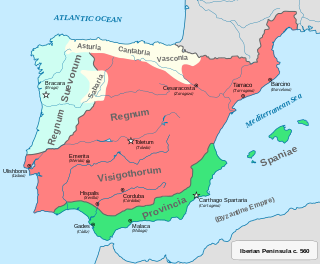Sources
- Arias, Jorge C. "Identity and Interactions: The Suevi and the Hispano-Romans." University of Virginia: Spring 2007.
| Preceded by Audeca | King of Galicia 585 | Succeeded by conquest |
Malaric or Amalaric was the last man to claim the kingship of the Suevi of Galicia. In 585, after the last king, Audeca, was defeated and captured by the Visigoths, Malaric, who claimed to be related to king Miro, rose in rebellion. According to John of Biclar, he was "defeated by King Leovigild's generals and was captured and presented in chains to Leovigild."
| Preceded by Audeca | King of Galicia 585 | Succeeded by conquest |

Alaric II was the King of the Visigoths in 484–507. He succeeded his father Euric as king of the Visigoths in Toulouse on December 28, 484; he was the great-grandson of the more famous Alaric I, who sacked Rome in 410. He established his capital at Aire-sur-l'Adour in Aquitaine. His dominions included not only the majority of Hispania but also Gallia Aquitania and the greater part of an as-yet undivided Gallia Narbonensis.
Amalric or Amalaric is a personal name derived from the tribal name Amal and ric meaning "ruler, prince".

The Suebi were a large group of Germanic peoples originally from the Elbe river region in what is now Germany and Czechia. In the early Roman era they included many peoples with their own names such as the Marcomanni, Quadi, Hermunduri, Semnones, and Lombards. New groupings formed later such as the Alamanni and Bavarians and two kingdoms in the Migration Period were simply referred to as Suebian.

Reccared I was Visigothic King of Hispania and Septimania. His reign marked a climactic shift in history, with the king's renunciation of Arianism in favour of Catholicism in 587.
This is a historical timeline of the Iberian Peninsula during the period of the Germanic kingdoms.
Hermeric was the king of the Suevi in Galicia from perhaps as early as 406 and certainly no later than 419 until his retirement in 438. He was a pagan and an enemy of the Roman Empire throughout his life. He is given a reign of thirty-two years in most manuscripts of Isidore of Seville's Historia Suevorum, but one manuscript does list his reign as fourteen years.

Witteric was the Visigoth King of Hispania, Septimania and Galicia. He ruled from 603 to 610.

Sisebut was King of the Visigoths and ruler of Hispania and Septimania from 612 until his death.

Rechila was the Suevic King of Galicia from 438 until his death. There are few primary sources for his life, but Hydatius was a contemporary Christian (non-Arian) chronicler in Galicia.
Rechiar or Rechiarius was the Suevic king of Gallaecia from 448 until his death. He was the first Chalcedonian Christian (Catholic) Germanic king in Europe and one of the most innovative and belligerent of the Suevi monarchs. Despite his orthodox Christianity, Hydatius, the contemporary bishop and chronicler from Galicia who is the sole contemporary source for biographical details of Rechiar, established his reputation as that of a barbarian with little sense of Roman law, culture, or custom.

The Kingdom of the Suebi, also called the Kingdom of Gallæcia or Suebi Kingdom of Gallæcia, was a Germanic post-Roman kingdom that was one of the first to separate from the Roman Empire. Based in the former Roman provinces of Gallaecia and northern Lusitania, the de facto kingdom was established by the Suebi about 409, and during the 6th century it became a formally declared kingdom identifying with Gallaecia. It maintained its independence until 585, when it was annexed by the Visigoths, and was turned into the sixth province of the Visigothic Kingdom in Hispania.
Aioulf or Ag(r)iwulf was an obscure King of Galicia from 456. In 448, after eight years in captivity, the Roman ambassador Censorius was executed by one Agiulf at Seville (Hispalis). This Agiulf has sometimes been identified with Aioulf.

Theodemir or Theodemar was one of the last Suevic kings of Galicia and one of the first Chalcedonian Christians to hold the title. He succeeded Ariamir sometime between the end of May 561 and the year 566 and ruled until his death.

Miro was the Suebian King of Galicia from 570 until his death in 583. His reign was marked by attempts to forge alliances with other Chalcedonian Christian nations with the goal of checking the power of the Arian Visigoths under Leovigild. During his reign relations were established with both Francia and the Byzantine Empire and the kingdom reached its zenith, but it collapsed within three years of his death.
Eboric or Euric was the last legitimate Suevic King of Galicia. He was the adolescent son of Miro and Sisegutia and he succeeded his father in 583, ruling for a year before being deposed by his mother's second husband, Audeca, who threw him in a monastery. His deposition gave the Visigothic king Leovigild casus belli to invade Galicia and remove Audeca from power.
Audeca or Andeca was the last Suevic King of Galicia from 584 until his deposition in 585. He deposed Eboric and usurped the throne by marrying the young king's mother, Siseguntia, the widow of Eboric's father and predecessor, Miro. He consigned Eboric to a monastery.

Spania was a province of the Byzantine Empire from 552 until 624 in the south of the Iberian Peninsula and the Balearic Islands. It was established by the Emperor Justinian I in an effort to restore the western provinces of the Empire.

Masona or Mausona was the Bishop of Mérida and metropolitan of the province of Lusitania from about 570 until his death. He is famous for exercising de facto rule of the city of Mérida during his tenure as bishop and for founding the first confirmed hospital in Spain.
The Ruccones were a people group, probably related to the Astures or the Basques, who lived semi-autonomously in northern Hispania from the fifth through to the seventh centuries. Their population area extended approximately from modern-day Asturias to La Rioja.